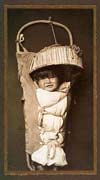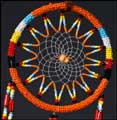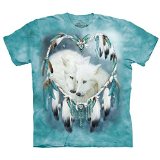Oban's Myths & Legends
More About Dream Catchers
 Dream catchers are made and used by many Native American nations and tribes, but they aren’t part of traditional culture.
Dream catchers are made and used by many Native American nations and tribes, but they aren’t part of traditional culture.
People of the Ojibwa tribe say they made the first dream catchers in ancient times.
They used freshly-cut twigs from willow trees, stinging nettle stalks, animal sinews and owl feathers. They fastened the twigs into a circle and then dried them to make the frame. Then they wove the plant stalks and sinews across and around the frame to make the web, making longer hanging threads to tie the feathers onto.
 Ojibwa grandparents made smaller dream catchers to hang on the cradle boards of their grand children. Each time the feathers moved while a child was sleeping, they believed a good dream drifted down onto the child.
Ojibwa grandparents made smaller dream catchers to hang on the cradle boards of their grand children. Each time the feathers moved while a child was sleeping, they believed a good dream drifted down onto the child.
They also gave dream catchers as good luck presents to young people when they married.
People still hang dream catchers over their beds. They believe that when a dream catcher moves in the air, it catches dreams as they float by.
Good dreams know their way through the web. They slip through the hole in the centre, slide down the hanging threads and over the feathers to bring good dreams to the person sleeping. Bad dreams don’t know the way to go and are trapped in the web. When daylight comes, they disappear.

Today dream catchers are made with many different materials. Some have beads as well as feathers and they may have one semi-precious gemstone too, as a symbol of the creator of the web of life or nature. People hang them in lots of places, not just on cradleboards or in children’s rooms. They hang in living rooms and from rearview mirrors in cars and trucks. They are also very popular with tourists.
 Some people think dream catchers are a lovely thing to have. Others see them as something that brings together many Native American cultures.
Some people think dream catchers are a lovely thing to have. Others see them as something that brings together many Native American cultures.
Dream catchers made by artists and craftspeople are beautiful to look at and calming and peaceful to watch, as the feathers move and sway in a breeze. These dream catchers are made with the same loving care as those made by Ojibwa people long ago.
Legend of How The Dream Catcher Was Made >>







